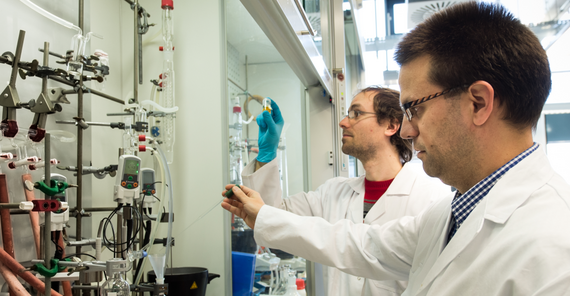We all know – sweet and sour things are not good for our teeth. A short aqueous citric acid bath is enough to affect the hard dental enamel. A look through the microscope shows a scene of destruction. The first signs are visible after only 30 seconds. A few minutes later, fissures are formed. It does not even take half an hour until so much calcium phosphate has been dissolved out that the shining surface of the tooth looks like a miniaturized cratered landscape. Caries-causing bacteria have an easy time now. They can now settle in and continue their destructive work, with the well-known, often painful and always irreversible consequences.
“A tooth is not bone,” Andreas Taubert says raising his hands: “If something gets broken here, nothing will grow again.” The chemist sees this fact as a big challenge. Taubert is professor of supramolecular chemistry and inorganic hybrid materials. For almost ten years he has examined how to produce inorganic materials in a controlled way. He and his research group look for chemical solutions to better protect enamel and to repair damage with minimally invasive methods. This means without drill and filling material.
Will it be possible to create the surface of a tooth in such a way that new calcium phosphate can be precipitated from saliva and the tooth can virtually repair itself? Although Taubert does time-consuming basic research, he considers this a concrete application: an additive to toothpaste or mouthwash, for instance, which prevents the withdrawal of calcium phosphate from enamel and initiates a process of remineralisation. The scientist estimates realistically that this will take another five to ten years.
First you have to find out what exactly happens on the tooth surface. Taubert is not a medical doctor but he has close contacts to the School of Dental Medicine at the University of Berne. They prepared the microscopic images of the acid attack on the enamel for him. They also raise the medical questions and provide him with the biological background knowledge. “A thin film from the proteins of saliva form on teeth soon after cleaning. This is called pellicle. It prevents abrasion caused by chewing and protects the enamel against the dangerous acid attack,” the chemist explains and adds what the decisive problem is: “If you do not brush your teeth regularly, the protective film becomes the perfect culture medium for various bacteria – the basis for plaque.”
Thorough analyses of the pellicle have shown that a first generation of bacteria grows at the beginning, and later the harmful caries bacteria are deposited. To avoid this danger from the outset, Taubert’s group is trying to produce polymers that interact with the protective film and should ensure that the first generation of bacteria cannot settle.
So far the research scientists have experimented with two different types of polymers and analysed their interaction with the pellicle. PhD student Tobias Mai tested polyethylene glycol, a well-known industrial polymer to which bacteria cannot stick very well. He proved that the slippery effect of the polymer in the natural protective film of the tooth gets even stronger. “There seem to be synergies,” Taubert says. “This is a very good start, but now we want to know how the effect comes about.”
Each answer raises ten new questions. “I know that I am sometimes quite impatient,” Taubert laughs and he tells us that he had to learn as a young scientist that research processes need time. He did not lose his contagious thirst for knowledge though. More than ten up-and-coming scientists are in his team. Like Tobias Mai there are some who “have sunk their teeth” into the dental topic. They very much appreciate the open and uncomplicated atmosphere in which each unexpected event becomes a source of new ideas. “We can also learn from intended strategies that did not work out. Nothing can go wrong actually,” Tobias Mai says.
Taubert encourages the young people to persevere, to overcome obstacles and not to be frustrated by failures. There are still lots of uncertainties when it comes to the crystallization of calcium phosphate that should grow on the damaged surface of the tooth and repair it. Only two of the over 20 calcium phosphates we know seem to fit at all: hydroxylapatite and fluorapatite. The scientists experimented with a gold surface first on which they let a brushlike polymer layer grow. It turned out to be a suitable “soil” for the crystallization of calcium phosphate. “Such model systems help us to better understand the very complex process of mineralization,” Taubert says. The scientists do not know yet how the polymer layer will react to tooth surface or saliva. It is also unclear how calcium phosphate should find the correct spot in the mouth. “If it mineralizes in the wrong place, scale will form,” Taubert explains the unwanted effect and shrugs.
The multitude of open questions does not distract the chemist. He sees himself at the intersection of basic and applied research. For him, specific technological problems in medical engineering are as spurring as biomimetics inspired by nature. Only when we understand how the body forms bones and teeth out of mineral crystals and organic macromolecules will we be able to artificially “replicate” similar composite material. And, Taubert says, the demand for this is increasing.
The Project
Bioinspired Calcium Phosphate Mineralization
www.chem.uni-potsdam.de/atb/index.htm
The Scientist
Professor Andreas Taubert studied chemistry in Basel. He took his PhD degree in Mainz in 2000. He became assistant professor at the University of Potsdam and at the Max Planck Institute of Colloids and Interfaces in 2006. Since 2011 he has been Associate Professor of Supramolecular Chemistry and Anorganic Hybrid Materials.
Contact
Universität Potsdam
Institut für Chemie
Karl-Liebknecht-Straße 24–25
14476 Potsdam
E-Mail: ataubertuuni-potsdampde
Text: Antje Horn-Conrad, Web Content Editing: Julia Schwaibold, Translation: Susanne Voigt

